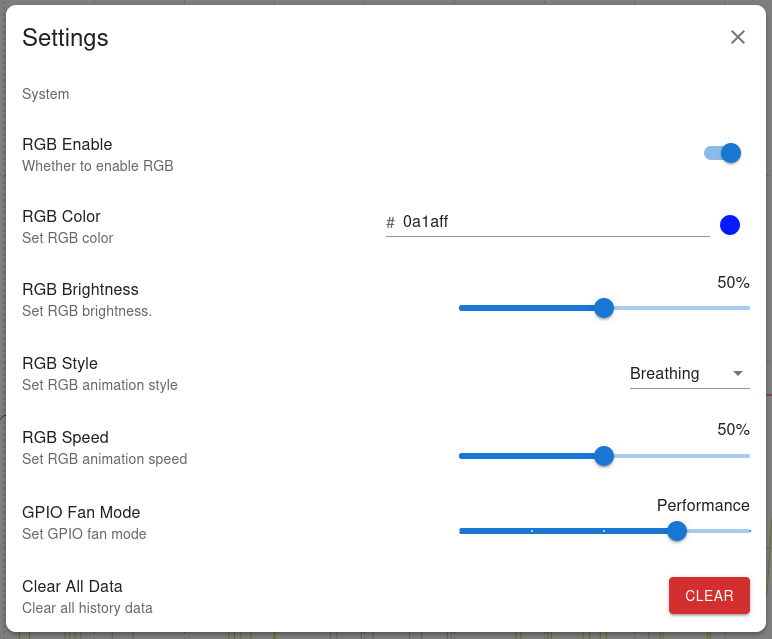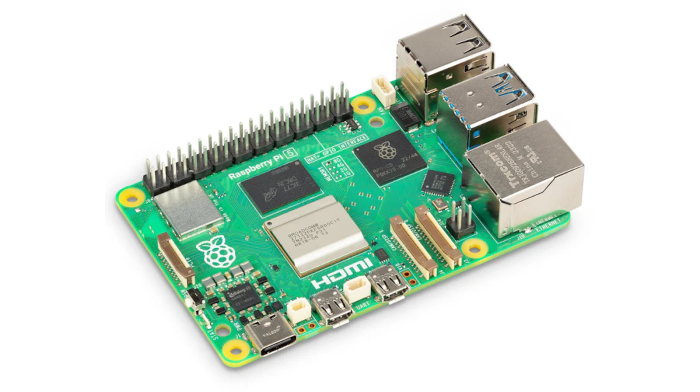Cooling
While it’s possible to run a Raspberry Pi 5 without cooling, it’s definitely not recommended. You’ll experience thermal throttling with heavy sustained loads.
One of the strengths of the Pironman 5 case is its awesome cooling. The cooling system consists of a tower cooler with copper pipes and PWM fan, and 2 RGB fans. Cool air enters the case primarily through the GPIO interface and other small openings. It then passes through the tower cooler, equipped with a high-performance fan, and is finally expelled through the 2 RGB fans on the side panel.
The PWN fan adjusts its speed depending on the temperature of the Raspberry Pi 5. I really like silent machines. And I’m not disappointed here. The PWM fan is off when the Pi’s temperature is below 50°C. And it almost always is below that temperature.
The tower cooler is so effective at cooling the Pi, its PWM fan only comes on if the CPU is maxed out, peaking at around 52°C. And even with room temperature at 25°C (that’s warm for May in the UK) I couldn’t get the fan to operate at anything more than 30% speed with heavy sustained load. At that speed, the PWM fan is inaudible from 1 metre. Even really close up, the fan is extremely quiet. And when the Raspberry Pi 5’s temperature is below 50°C, the 2 RGB fans don’t come on unless the GPIO fan mode is set to always on. Therefore, the case keeps the system extremely cool yet remains silent. The perfect combination.
Here’s an image of some of the settings we can tweak. I’ve set the GPIO Fan Mode to Performance. At that setting the case fans turn on when the CPU reaches 50°C. The 2 RGB fans are not particularly quiet, but they rarely come on in performance mode.

All the fan modes:
- Quiet: The RGB fans activate at 70°C.
- Balanced: The RGB fans activate at 67.5°C.
- Cool: The RGB fans activate at 60°C.
- Performance: The RGB fans activate at 50°C.
- Always On: The RGB fans are always on.
Note that even with a room temperature of 25°C, the case fans never activate in quiet, balanced, or cool modes. That’s a testament to the cooling prowess of the tower cooler.
Next page: Page 4 – Disk Performance
Pages in this article:
Page 1 – Introduction and Assembly
Page 2 – Software
Page 3 – Cooling
Page 4 – Disk Performance
Page 5 – WiFi Performance
Page 6 – Summary
All articles in this series:
| Raspberry Pi 5 Series | |
|---|---|
Hardware | |
| iRasptek Starter Kit | All the kit you need to get started with the Pi 5 |
| Pironman 5 Case Review | Transform the Pi 5 into a beautiful desktop mini PC |
| Passive Cooling the Pi 5 | Passively cool your Pi 5 the right way. Silent yet cool |
| Benchmarking | Benchmarking the Pi 5 against an Intel N100 mini PC |
| Overclocking | Let's increase the clock speed of the BCM2712 SoC |
| Power Consumption | Compare the power consumption of the Pi 5 with Intel Mini PCs |
| 2.5Gbps Networking | Improving the wired performance of the Pi 5 |
| WiFi | Improve WiFi performance of the Pi 5 |
| Desktop PC | Is the Pi 5 good value compared to an Intel N100 Mini PC? |
Configuration | |
| raspi-config | Useful text-based tool to configure the Pi 5 |
| PiGro | GUI tool that streamlines the process of managing the Pi 5 |
| Increase Swap Memory Size | Increase the swap size from 512MB to 2GB |
| ZRAM swapdrive | Simple script to use a ZRAM swapdrive instead of a swapfile |
Software | |
| Installing Software | Different ways to install software on the Pi 5 |
| df snap pollution | Replace df with dysk |
| Ollama GUI | Running Large Language Models on the Pi 5 |
| Music Players | GUI and TUI music players explored |
| Internet Radio | Exploring the best options for both GUI and TUI software |
| Many software articles are planned. Stay tuned! | |
